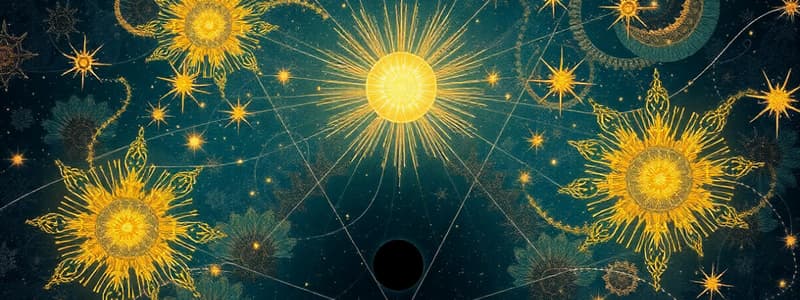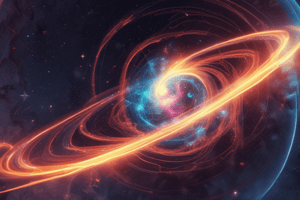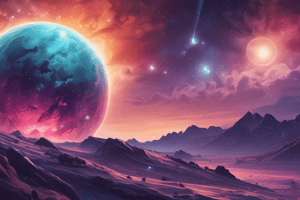Podcast
Questions and Answers
What is the primary composition of a neutron star?
What is the primary composition of a neutron star?
- Electrons
- Protons
- Neutrons (correct)
- Hydrogen
What can cause a neutron star to emit high-frequency radio waves?
What can cause a neutron star to emit high-frequency radio waves?
- Its mass collapsing inward
- The formation of a black hole
- Excessive gravitational pull
- Its rapid rotation (correct)
What happens to stars with an initial mass greater than 30 solar masses upon dying?
What happens to stars with an initial mass greater than 30 solar masses upon dying?
- They form red giants
- They explode into supernovae
- They become neutron stars
- They collapse into black holes (correct)
How does the immense gravity of a black hole affect nearby matter?
How does the immense gravity of a black hole affect nearby matter?
What observable effect can be detected from matter spiraling into a black hole?
What observable effect can be detected from matter spiraling into a black hole?
What is a pulsar?
What is a pulsar?
What visual phenomenon is seen near a massive black hole, according to the figures?
What visual phenomenon is seen near a massive black hole, according to the figures?
What primarily determines the life cycle stage of a star?
What primarily determines the life cycle stage of a star?
What initiates the formation of a star within a nebula?
What initiates the formation of a star within a nebula?
At what temperature does nuclear fusion begin in the core of a protostar?
At what temperature does nuclear fusion begin in the core of a protostar?
What primarily determines the lifespan of a star?
What primarily determines the lifespan of a star?
What process stabilizes a star after nuclear fusion begins?
What process stabilizes a star after nuclear fusion begins?
What forms when clumps of gas and dust in a nebula become more massive?
What forms when clumps of gas and dust in a nebula become more massive?
What type of radiation is emitted as a result of nuclear fusion in stars?
What type of radiation is emitted as a result of nuclear fusion in stars?
How long does the process of a protostar becoming a star take for a star like the Sun?
How long does the process of a protostar becoming a star take for a star like the Sun?
What is the role of gravity in the formation of stars?
What is the role of gravity in the formation of stars?
What happens to a massive star when it runs out of hydrogen for fusion?
What happens to a massive star when it runs out of hydrogen for fusion?
Which element is produced when a massive star undergoes fusion after carbon?
Which element is produced when a massive star undergoes fusion after carbon?
What is the final element that can be formed in fusion processes within massive stars?
What is the final element that can be formed in fusion processes within massive stars?
What occurs during a supernova explosion?
What occurs during a supernova explosion?
How does the gravity of a neutron star compare to that of Earth?
How does the gravity of a neutron star compare to that of Earth?
What phenomenon is observed in neutron stars that spin rapidly?
What phenomenon is observed in neutron stars that spin rapidly?
Which of the following best describes the size of a neutron star?
Which of the following best describes the size of a neutron star?
What is the result of a supernova explosion on surrounding matter?
What is the result of a supernova explosion on surrounding matter?
What happens to a star's outer layers during the red giant phase?
What happens to a star's outer layers during the red giant phase?
Which of the following correctly identifies the end result of a high mass star's life cycle?
Which of the following correctly identifies the end result of a high mass star's life cycle?
What is the primary factor determining a star's evolutionary path?
What is the primary factor determining a star's evolutionary path?
Which of the following physical properties is used in the Hertzsprung-Russell diagram?
Which of the following physical properties is used in the Hertzsprung-Russell diagram?
How do astronomers usually detect black holes?
How do astronomers usually detect black holes?
Which statement about a white dwarf is accurate?
Which statement about a white dwarf is accurate?
What distinguishes a supergiant from a regular giant star?
What distinguishes a supergiant from a regular giant star?
What role do nebulas play in star formation?
What role do nebulas play in star formation?
What initiates the process of nuclear fusion in a protostar?
What initiates the process of nuclear fusion in a protostar?
In which part of a star is radiation emitted after nuclear fusion occurs?
In which part of a star is radiation emitted after nuclear fusion occurs?
What does the Hertzsprung-Russell diagram plot against each other?
What does the Hertzsprung-Russell diagram plot against each other?
How is the life cycle of a star primarily determined?
How is the life cycle of a star primarily determined?
What characteristic of stars is observed to change as they evolve?
What characteristic of stars is observed to change as they evolve?
Where do the majority of stars fall on the H-R diagram?
Where do the majority of stars fall on the H-R diagram?
What type of stars are found in the lower right corner of the H-R diagram?
What type of stars are found in the lower right corner of the H-R diagram?
What influence does a star's mass have on its rate of fusion?
What influence does a star's mass have on its rate of fusion?
What is the typical appearance of blue stars?
What is the typical appearance of blue stars?
What occurs when a protostar has sufficient energy from nuclear fusion?
What occurs when a protostar has sufficient energy from nuclear fusion?
What is the final stage for a small to medium star after its death?
What is the final stage for a small to medium star after its death?
How long does a star with mass equal to the Sun typically remain in the main sequence stage?
How long does a star with mass equal to the Sun typically remain in the main sequence stage?
What happens to the core of a red supergiant star at the end of its life cycle?
What happens to the core of a red supergiant star at the end of its life cycle?
During which stage does a star use nuclear fusion to produce energy for only a few million years?
During which stage does a star use nuclear fusion to produce energy for only a few million years?
What occurs to the remains of a massive star after its supernova?
What occurs to the remains of a massive star after its supernova?
What is the primary cause of a star becoming a red giant?
What is the primary cause of a star becoming a red giant?
What is formed after a star of similar mass to the Sun dies?
What is formed after a star of similar mass to the Sun dies?
How does the luminosity of a red giant compare to that of a main sequence star?
How does the luminosity of a red giant compare to that of a main sequence star?
What happens to the outer layers of a star when it becomes a white dwarf?
What happens to the outer layers of a star when it becomes a white dwarf?
What is the fate of a white dwarf over a long period?
What is the fate of a white dwarf over a long period?
What primarily leads to the core collapse of more massive stars?
What primarily leads to the core collapse of more massive stars?
Which of the following occurs during the formation of a planetary nebula?
Which of the following occurs during the formation of a planetary nebula?
What do stars that are more massive than the Sun do more quickly than less massive stars?
What do stars that are more massive than the Sun do more quickly than less massive stars?
What is the main characteristic of stars located on the main sequence of the H-R diagram?
What is the main characteristic of stars located on the main sequence of the H-R diagram?
What happens to a star like the Sun after it exhausts its hydrogen supply?
What happens to a star like the Sun after it exhausts its hydrogen supply?
Which type of star is characterized by both high mass and high luminosity in the upper left area of the H-R diagram?
Which type of star is characterized by both high mass and high luminosity in the upper left area of the H-R diagram?
How do cooler and less luminous stars achieve greater luminosity than hotter stars?
How do cooler and less luminous stars achieve greater luminosity than hotter stars?
What is a characteristic of the stars termed 'red giants' on the H-R diagram?
What is a characteristic of the stars termed 'red giants' on the H-R diagram?
What fuels a red supergiant during its later stages of life after hydrogen fusion?
What fuels a red supergiant during its later stages of life after hydrogen fusion?
What effect does the decrease in hydrogen levels in the core of a star like the Sun have on its outer layers?
What effect does the decrease in hydrogen levels in the core of a star like the Sun have on its outer layers?
What is the approximate lifetime of a star on the main sequence that is similar in mass to the Sun?
What is the approximate lifetime of a star on the main sequence that is similar in mass to the Sun?
Where do roughly 90% of stars fall on the H-R diagram?
Where do roughly 90% of stars fall on the H-R diagram?
What main process keeps stars stationary on the main sequence during their lifetime?
What main process keeps stars stationary on the main sequence during their lifetime?
Flashcards
Nebula
Nebula
A massive cloud of interstellar gas and dust, primarily hydrogen and helium, where stars are born.
Nuclear Fusion
Nuclear Fusion
The process where hydrogen atoms fuse to form helium atoms, releasing a tremendous amount of energy.
Protostar
Protostar
A stage in a star's formation where a dense core, formed from collapsing nebula material, starts to heat up and glow, but nuclear fusion hasn't begun yet.
Radiation Pressure
Radiation Pressure
Signup and view all the flashcards
Gravity
Gravity
Signup and view all the flashcards
Star Lifespan
Star Lifespan
Signup and view all the flashcards
Nuclear Fusion Ignition
Nuclear Fusion Ignition
Signup and view all the flashcards
Fusion Rate
Fusion Rate
Signup and view all the flashcards
What is a neutron star?
What is a neutron star?
Signup and view all the flashcards
What is a pulsar?
What is a pulsar?
Signup and view all the flashcards
What is a black hole?
What is a black hole?
Signup and view all the flashcards
How does a black hole interact with nearby stars?
How does a black hole interact with nearby stars?
Signup and view all the flashcards
What is significant about the Crab Pulsar and Crab Nebula?
What is significant about the Crab Pulsar and Crab Nebula?
Signup and view all the flashcards
How do the life cycles of massive stars differ from low-mass stars?
How do the life cycles of massive stars differ from low-mass stars?
Signup and view all the flashcards
What is the link between a star's mass and its life cycle?
What is the link between a star's mass and its life cycle?
Signup and view all the flashcards
Supernova
Supernova
Signup and view all the flashcards
Neutron star
Neutron star
Signup and view all the flashcards
Iron core collapse
Iron core collapse
Signup and view all the flashcards
Pulsars
Pulsars
Signup and view all the flashcards
Massive star
Massive star
Signup and view all the flashcards
Hydrogen fusion
Hydrogen fusion
Signup and view all the flashcards
Supernova remnant
Supernova remnant
Signup and view all the flashcards
Red Giant
Red Giant
Signup and view all the flashcards
Supergiant
Supergiant
Signup and view all the flashcards
Black Hole
Black Hole
Signup and view all the flashcards
White Dwarf
White Dwarf
Signup and view all the flashcards
Hertzsprung-Russell Diagram (H-R Diagram)
Hertzsprung-Russell Diagram (H-R Diagram)
Signup and view all the flashcards
What is a nebula?
What is a nebula?
Signup and view all the flashcards
What is nuclear fusion?
What is nuclear fusion?
Signup and view all the flashcards
How does a star's mass affect its lifespan?
How does a star's mass affect its lifespan?
Signup and view all the flashcards
What is a white dwarf?
What is a white dwarf?
Signup and view all the flashcards
What is a supernova?
What is a supernova?
Signup and view all the flashcards
What is nuclear fusion ignition?
What is nuclear fusion ignition?
Signup and view all the flashcards
What is fusion rate?
What is fusion rate?
Signup and view all the flashcards
What is the Hertzsprung-Russell (H-R) diagram?
What is the Hertzsprung-Russell (H-R) diagram?
Signup and view all the flashcards
What is the main sequence?
What is the main sequence?
Signup and view all the flashcards
What are off-main sequence stars?
What are off-main sequence stars?
Signup and view all the flashcards
What is radiation pressure?
What is radiation pressure?
Signup and view all the flashcards
How does a star's mass affect its life cycle?
How does a star's mass affect its life cycle?
Signup and view all the flashcards
What is a star's lifespan?
What is a star's lifespan?
Signup and view all the flashcards
Red Supergiant
Red Supergiant
Signup and view all the flashcards
End of Nuclear Fusion
End of Nuclear Fusion
Signup and view all the flashcards
Planetary Nebula
Planetary Nebula
Signup and view all the flashcards
Helium Fusion
Helium Fusion
Signup and view all the flashcards
Main Sequence
Main Sequence
Signup and view all the flashcards
Main Sequence Star
Main Sequence Star
Signup and view all the flashcards
Death of a Star
Death of a Star
Signup and view all the flashcards
Red Giant Formation
Red Giant Formation
Signup and view all the flashcards
Evolution from Main Sequence to Red Giant
Evolution from Main Sequence to Red Giant
Signup and view all the flashcards
Temperature and Size Correlation
Temperature and Size Correlation
Signup and view all the flashcards
Classifying Stars on the H-R Diagram
Classifying Stars on the H-R Diagram
Signup and view all the flashcards
Study Notes
The Life Cycle of Stars
- Every star has a unique life cycle, with a beginning, middle, and end
- The life of a star may last billions of years
- Scientists use modern instruments to study stars at different stages of their life cycle
- Stars are formed inside giant clouds of gas and dust called nebulae
- Nebulae are primarily composed of hydrogen and helium
- When parts of a nebula collapse, the gases clump together increasing their density and gravity
- Gravitational forces pull the gas and dust particles together, drawing them from the clouds
- As the clumps draw in gas and dust they become more massive
- These regions have stronger gravity forming within the nebula
- The nebula continues to pull in gas and dust. Over time, forming a protostar
- The mass and gravity of the protostar increases, becoming tightly packed
- The force of gravity causes the atoms in the core of the protostar to become tightly packed resulting in higher pressure and nuclear fusion
- Nuclear fusion begins in the core of the protostar
Nuclear Fusion
- For millions of years, the core of the protostar continues to contract due to the pull of gravity
- The core temperature rises until it meets a critical temperature
- Hydrogen atoms fuse to form helium, producing enormous amounts of energy
- This energy forces outwards from the core, creating a star
- The newly formed star emits energy in the form of light and heat
The Hertzsprung-Russell Diagram
- Astronomers use the Hertzsprung-Russell diagram to categorize stars based on their luminosity and temperature
- The mass of a star determines its life cycle or evolution
Studying That Suits You
Use AI to generate personalized quizzes and flashcards to suit your learning preferences.




